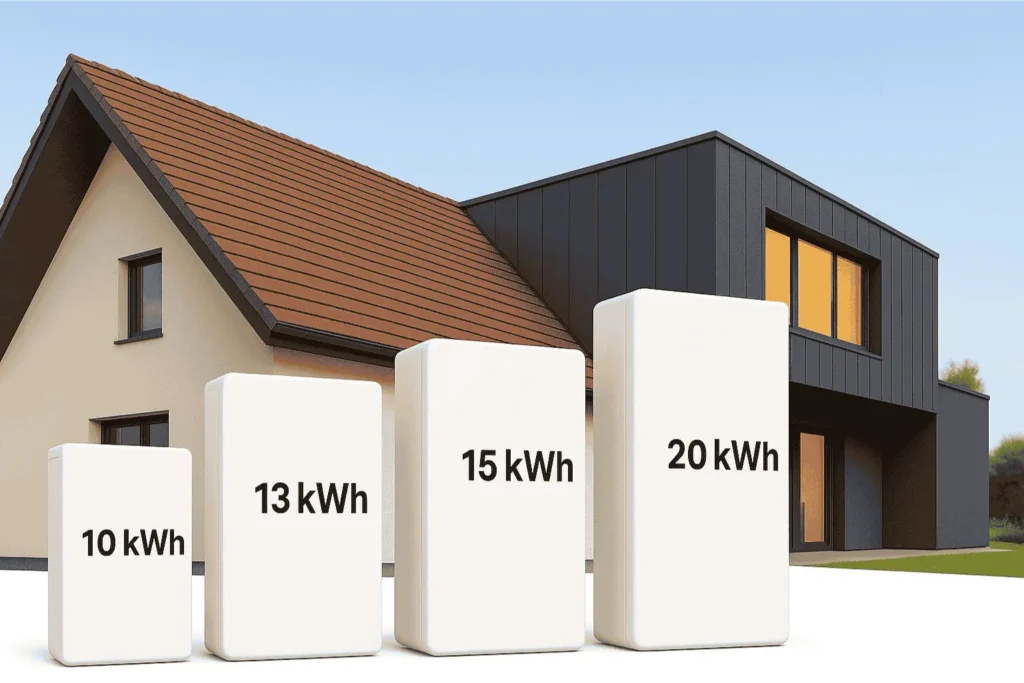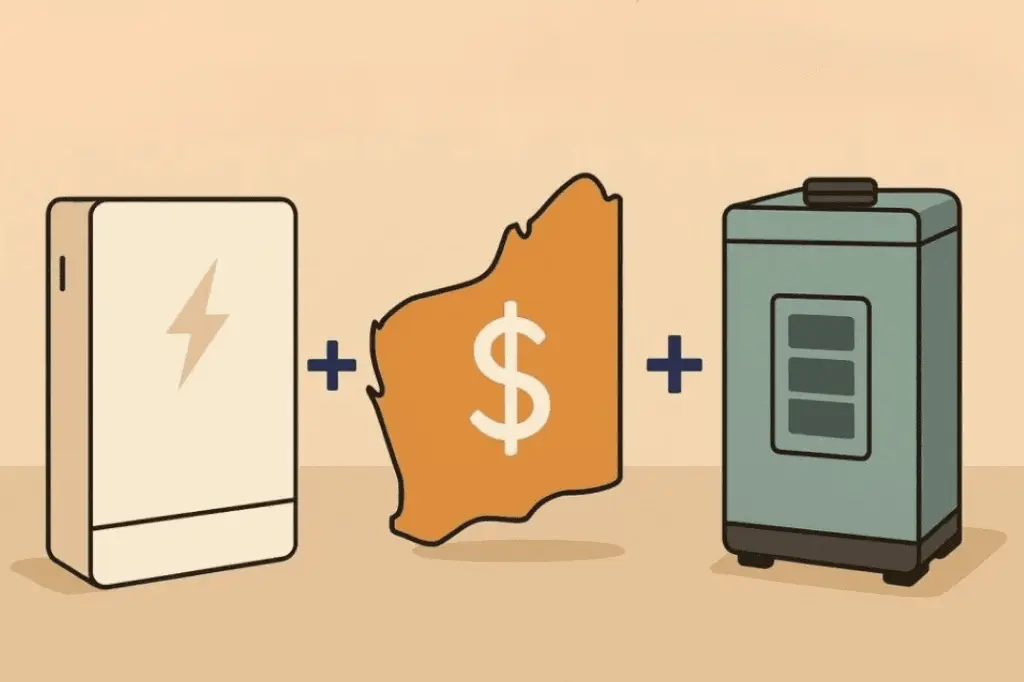Updated June 2025
If you already have solar or are planning to install it, adding a battery can help you reduce your electricity bills, store excess solar for use at night, and protect your home during blackouts. But how much does a battery actually cost in 2025?
This guide breaks down real-world pricing for 10kWh, 13kWh, 15kWh and 20kWh battery systems in Australia. You’ll see typical installed costs after rebates, examples from leading battery brands, and guidance on which system might best suit your needs.
All solar battery prices shown include installation and apply after the federal battery rebate has been applied. These are real figures based on current market rates from trusted installers.
Important note: Final pricing can vary depending on your home’s specific installation needs, including switchboard upgrades, cable runs, inverter compatibility, and whether you have single phase or three phase power. The pricing in this guide assumes a standard single phase installation with no major electrical modifications.
In some states, additional battery rebates or VPP incentives may reduce your out-of-pocket cost even further. You can check your eligibility here.
Understanding Battery Sizing: What Does 10kW Actually Mean?
When you see a battery described as “10kW,” “15kW” or similar, it’s usually referring to energy storage capacity, not power output.
Technically, the correct term is kilowatt-hours (kWh). This measures how much energy a battery can store and deliver to your home. It’s the same unit you see on your power bill.
- kWh (kilowatt-hours) = the total amount of energy stored
- kW (kilowatts) = how fast the battery can charge or discharge
For example, a 10kWh battery can supply 2kW of power for 5 hours, or 5kW of power for 2 hours, depending on your home’s usage.
In this article, we’ll refer to battery size by its usable storage capacity in kilowatt-hours, which is the industry standard when comparing systems.
10kWh Solar Battery Price in Australia
A 10kWh battery is one of the most common choices for Australian homes. It provides enough storage to cover most evening usage and can be configured to offer backup protection during blackouts.
System Example: Sungrow SBR096 (9.6kWh usable) + 5kW Hybrid Inverter
| Description | Price Range |
|---|---|
| Typical Retail Price (before rebate) | $12,000 to $14,000 |
| Federal Battery Rebate (approx.) | ~$3,400 |
| Estimated Final Cost (after rebate) | $8,600 to $10,600 |
This size is ideal for:
- Homes with 6.6kW to 10kW of solar
- Households using 8 to 10kWh of electricity after sunset
- Families of three or four
- Those wanting to store excess solar instead of exporting it
- Customers needing essential circuit backup during outages
13kWh Solar Battery Price in Australia
If your home has higher electricity usage in the evenings or you’re planning to join a Virtual Power Plant, a 13kWh battery offers extra capacity and flexibility. Tesla’s Powerwall 3 is currently one of the most popular systems in this size range.
System Example: Tesla Powerwall 3 (13.5kWh usable) with 10kW Built-In Inverter
| Description | Price Range |
|---|---|
| Typical Retail Price (before rebate) | $17,500 to $19,500 |
| Federal Battery Rebate (approx.) | ~$4,750 |
| Estimated Final Cost (after rebate) | $12,750 to $14,750 |
This size is ideal for:
- Homes with larger solar systems (10 to 13kW)
- Households using 12 to 14kWh of electricity after sunset
- Customers wanting all-in-one backup capability with minimal hardware clutter
15kWh Solar Battery Price in Australia
A 15kWh battery system offers storage capacity for homes with high night-time usage or those aiming to rely almost entirely on solar. It’s a smart choice for households looking for long-term energy security, especially when paired with a larger solar system.
System Example: Sigenergy SigenStack (15kWh usable) + 5kW Hybrid Inverter
| Description | Price Range |
|---|---|
| Typical Retail Price (before rebate) | $16,000 to $18,000 |
| Federal Battery Rebate (approx.) | ~$5,300 |
| Estimated Final Cost (after rebate) | $10,700 to $12,700 |
This size is ideal for:
- Homes with solar systems over 10kW
- Households using 12 to 16kWh of electricity after sunset
- Families planning to electrify appliances
- Customers wanting whole-home backup with automatic switching
- Those interested in future-proofing with a premium, modular system
20kWh Solar Battery Price in Australia
A 20kWh battery system provides enough storage to cover nearly all night-time electricity use for large homes. It’s also ideal for customers seeking full backup power or preparing for a partially off-grid setup.
System Example: Sigenergy SigenStack (20kWh usable) + 5kW Hybrid Inverter
| Description | Price Range |
|---|---|
| Typical Retail Price (before rebate) | $19,000 to $21,000 |
| Federal Battery Rebate (approx.) | ~$7,000 |
| Estimated Final Cost (after rebate) | $12,000 to $14,000 |
This size is ideal for:
- Homes with high night-time energy use
- Households with multiple electric appliances
- Families seeking complete blackout protection for the entire home
- Those who want to invest once and avoid future battery upgrades
Battery Price Comparison Summary
| Battery System | Usable Capacity | Typical Price (Before Rebate) | Federal Rebate (Approx.) | Final Cost (After Rebate) |
|---|---|---|---|---|
| Sungrow SBR096 + 5kW Hybrid Inverter | 9.6kWh | $12,000 to $14,000 | ~$3,400 | $8,600 to $10,600 |
| Tesla Powerwall 3 + 10kW Inverter | 13.5kWh | $17,500 to $19,500 | ~$4,750 | $12,750 to $14,750 |
| Sigenergy 15kWh + 5kW Inverter | 15kWh | $16,000 to $18,000 | ~$5,300 | $10,700 to $12,700 |
| Sigenergy 20kWh + 5kW Inverter | 20kWh | $19,000 to $21,000 | ~$7,000 | $12,000 to $14,000 |
These figures are indicative and assume standard single phase installation. Final pricing may vary depending on your home’s switchboard, cabling requirements, or inverter compatibility. Additional state-based rebates may further reduce the cost in some locations.
Should You Always Get a Bigger Battery?
Not necessarily. While it’s tempting to buy the largest battery you can afford, bigger doesn’t always mean better – especially when it comes to value for money.
The best battery for your home is the one that matches your solar generation, energy use, and goals.
A few things to consider:
1. How much solar do you export each day?
If your system doesn’t produce enough excess solar to fill a large battery, part of your investment may sit unused.
2. How much electricity do you use after sunset?
A 10kWh battery can power most homes through the evening. If you only use 5 to 7kWh at night, a 15kWh or 20kWh battery may be overkill.
3. Do you want backup for the whole home, or just the essentials?
Larger batteries can power everything during an outage, but many homes are satisfied with backup for lights, fridge, and Wi-Fi only.
4. Are you joining a Virtual Power Plant (VPP)?
Some VPPs prefer or require a certain battery size to maximize your participation and potential earnings.
5. Are you planning future upgrades?
If you’re planning to buy an EV or replace gas appliances with electric ones, it might make sense to size up now rather than retrofit later.
In short, the ideal battery is not always the biggest. It’s the one that’s properly sized for your solar system, energy usage, and backup expectations.
What If You Need More Than 20kWh?
While average Australian homes will be well served by a 10kWh to 20kWh battery, there are exceptions. Some properties, especially large households or all-electric homes, may benefit from even bigger storage systems.
Modular platforms like Sigenergy and Sungrow allow you to scale beyond 20kWh if needed. However, going bigger only makes sense if your solar system can keep up.
Bigger Battery? Make Sure You Have the Solar to Match
A large battery is only useful if you can reliably charge it.
This is especially important during winter, when solar generation is lower and daylight hours are shorter. Before committing to a larger battery, make sure your solar PV system is sized appropriately – ideally 10kW or more for 15kWh+ storage.
A good installer will model your energy generation across seasons and help you right-size both your solar and battery systems together.
Making the Right Choice
Battery storage is no longer just for early adopters. With falling prices and generous rebates, it’s now a smart option for many Australian homes.
Whether you’re installing a 10kWh system to shift evening usage or considering a 20kWh setup for full-home backup, the key is choosing a system that fits your energy needs, solar generation, and long-term plans.
For some households, especially those with electric vehicles or all-electric appliances, going beyond 20kWh may be worth considering. Just keep in mind that larger batteries require a large enough solar system to charge them effectively, particularly during winter months.
A well-matched battery will charge efficiently, support your lifestyle, and deliver consistent value year-round.





